Stewart J. Calculus
Подождите немного. Документ загружается.

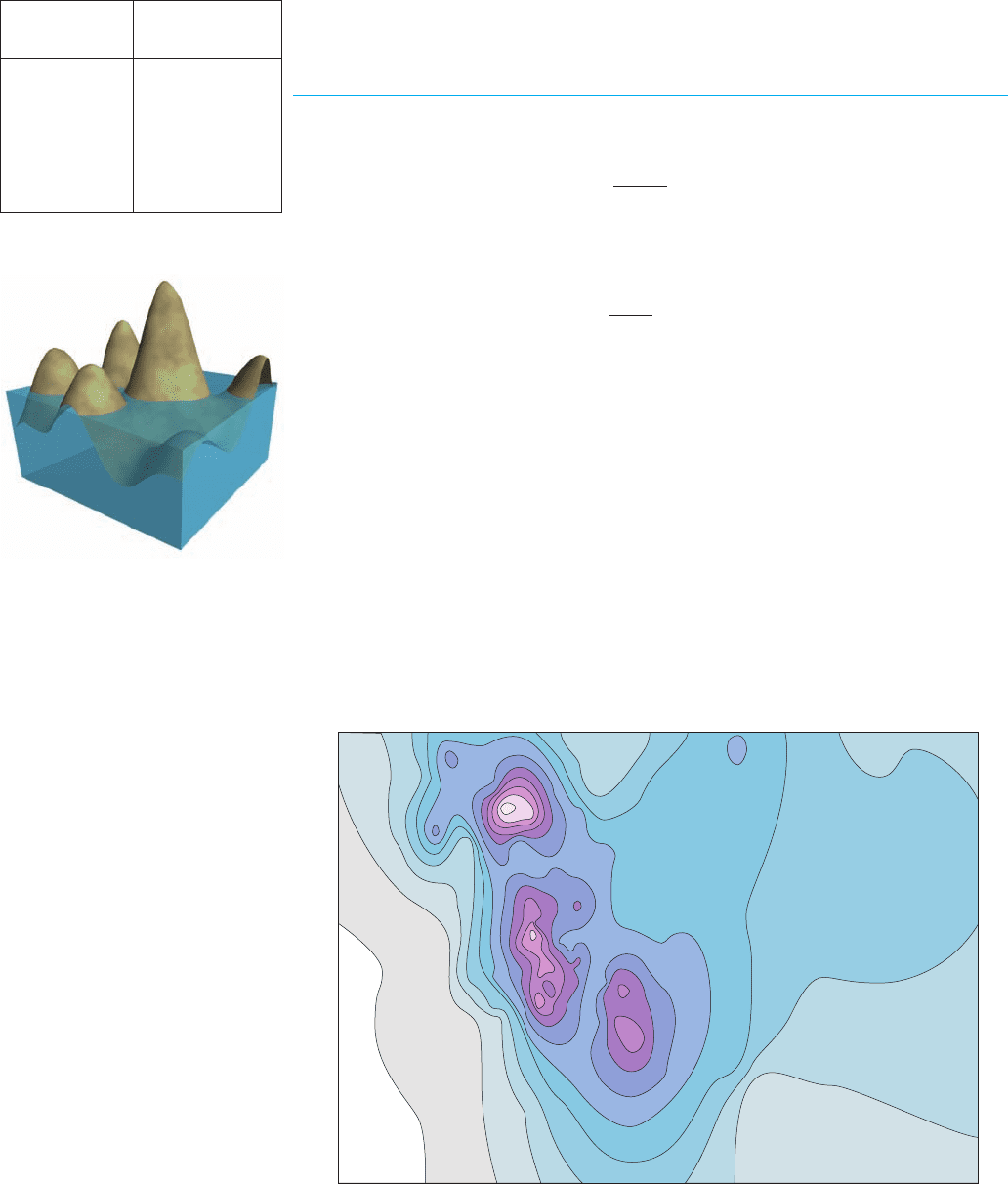
similar shape, we get the Midpoint Rule approximations displayed in the chart in the mar-
gin. Notice how these approximations approach the exact value of the double integral, .
AVERAGE VALUE
Recall from Section 6.5 that the average value of a function of one variable defined on
an interval is
In a similar fashion we define the average value of a function of two variables defined
on a rectangle R to be
where is the area of R.
If , the equation
says that the box with base and height has the same volume as the solid that lies
under the graph of . [If describes a mountainous region and you chop off the
tops of the mountains at height , then you can use them to fill in the valleys so that the
region becomes completely flat. See Figure 11.]
EXAMPLE 4 The contour map in Figure 12 shows the snowfall, in inches, that fell on the
state of Colorado on December 20 and 21, 2006. (The state is in the shape of a rectangle
that measures 388 mi west to east and 276 mi south to north.) Use the contour map to
estimate the average snowfall for the entire state of Colorado on those days.
12
12
8
0
4
8
12
16
12
16
16
20
20
24
24
24
28
28
28
32
32
32
36
36
40
40
44
FIGURE 12
f
ave
z 苷 f 共x, y兲f
f
ave
R
A共R兲 ⫻ f
ave
苷
yy
R
f 共x, y兲 dA
f 共x, y兲 艌 0
A共R兲
f
ave
苷
1
A共R兲
yy
R
f 共x, y兲 dA
f
f
ave
苷
1
b ⫺ a
y
b
a
f 共x兲 dx
关a, b兴
f
⫺12
992
||||
CHAPTER 16 MULTIPLE INTEGRALS
Number of Midpoint Rule
subrectangles approximations
1 ⫺11.5000
4 ⫺11.8750
16 ⫺11.9687
64 ⫺11.9922
256 ⫺11.9980
1024 ⫺11.9995
FIGURE 11
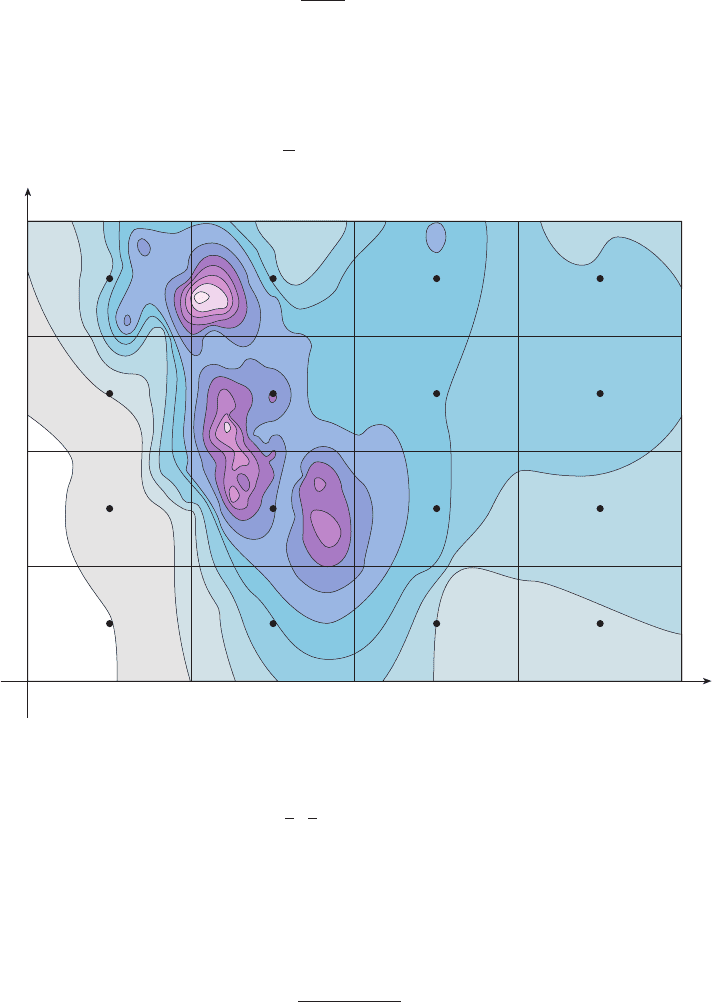
SOLUTION Let’s place the origin at the southwest corner of the state. Then
, and is the snowfall, in inches, at a location x miles to the east and
y miles to the north of the origin. If R is the rectangle that represents Colorado, then the
average snowfall for the state on December 20–21 was
where . To estimate the value of this double integral, let’s use the Mid-
point Rule with . In other words, we divide R into 16 subrectangles of equal
size, as in Figure 13. The area of each subrectangle is
Using the contour map to estimate the value of at the center of each subrectangle,
we get
Therefore
On December 20–21, 2006, Colorado received an average of approximately inches of
snow.
M
13
f
ave
⬇
共6693兲共207兲
共388兲共276兲
⬇ 12.9
苷 共6693兲共207兲
⫹ 4.5 ⫹ 28 ⫹ 17 ⫹ 13.5 ⫹ 12 ⫹ 15 ⫹ 17.5 ⫹ 13兴
⬇ ⌬A关0 ⫹ 15 ⫹ 8 ⫹ 7 ⫹ 2 ⫹ 25 ⫹ 18.5 ⫹ 11
yy
R
f 共x, y兲 dA ⬇
兺
4
i苷1
兺
4
j苷1
f 共x
i
, y
j
兲 ⌬A
f
12
12
8
0
4
8
12
16
12
16
16
20
20
24
24
24
28
28
28
32
32
32
36
36
40
40
44
276
388
0
y
x
FIGURE 13
⌬A 苷
1
16
共388兲共276兲 苷 6693 mi
2
m 苷 n 苷 4
A共R兲 苷 388 ⴢ 276
f
ave
苷
1
A共R兲
yy
R
f 共x, y兲 dA
f 共x, y兲0 艋 y 艋 276
0 艋 x 艋 388,
SECTION 16.1 DOUBLE INTEGRALS OVER RECTANGLES
||||
993
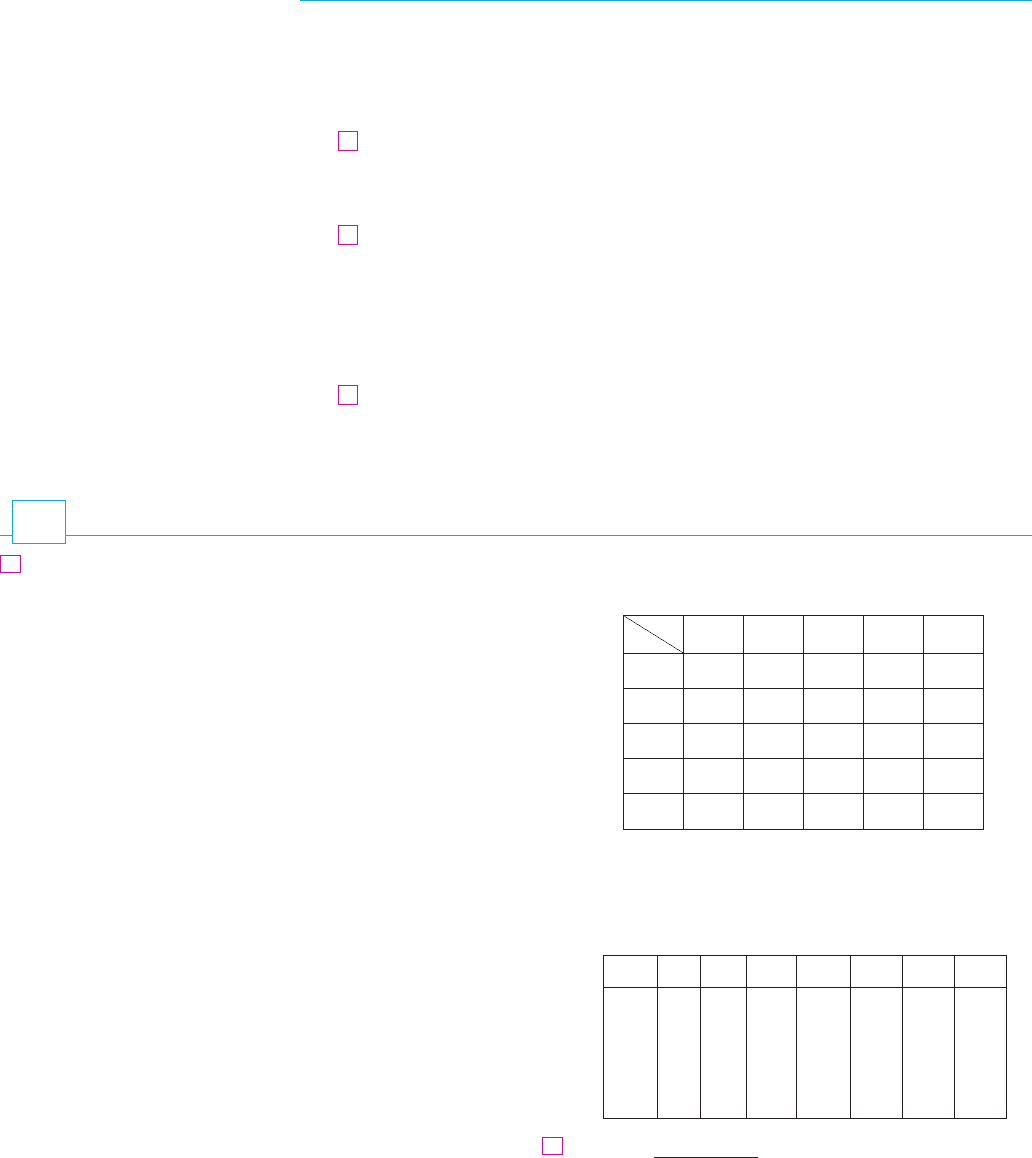
PROPERTIES OF DOUBLE INTEGRALS
We list here three properties of double integrals that can be proved in the same manner as
in Section 5.2. We assume that all of the integrals exist. Properties 7 and 8 are referred to
as the linearity of the integral.
where c is a constant
If for all in , then
yy
R
f 共x, y兲 dA 艌
yy
R
t共x, y兲 dA
9
R共x, y兲f 共x, y兲 艌 t共x, y兲
yy
R
cf共x, y兲 dA 苷 c
yy
R
f 共x, y兲 dA
8
yy
R
关 f 共x, y兲 ⫹ t共x, y兲兴 dA 苷
yy
R
f 共x, y兲 dA ⫹
yy
R
t共x, y兲 dA
7
994
||||
CHAPTER 16 MULTIPLE INTEGRALS
N Double integrals behave this way because
the double sums that define them behave
this way.
(b) Estimate the double integral with by choosing
the sample points to be the points farthest from the origin.
6. A 20-ft-by-30-ft swimming pool is filled with water. The depth
is measured at 5-ft intervals, starting at one corner of the pool,
and the values are recorded in the table. Estimate the volume of
water in the pool.
Let be the volume of the solid that lies under the graph of
and above the rectangle given by
, . We use the lines and to y 苷 4x 苷 32 艋 y 艋 62 艋 x 艋 4
f 共x, y兲 苷
s
52 ⫺ x
2
⫺ y
2
V
7.
2
3
4
5
7
0
1
3
5
8
⫺3
⫺4
0
3
6
⫺6
⫺8
⫺5
⫺1
3
⫺5
⫺6
⫺8
⫺4
0
x
y
01234
1.0
1.5
2.0
2.5
3.0
m 苷 n 苷 4
(a) Estimate the volume of the solid that lies below
the surface and above the rectangle
,
Use a Riemann sum with , , and take the sample
point to be the upper right corner of each square.
(b) Use the Midpoint Rule to estimate the volume of the solid
in part (a).
2. If , use a Riemann sum with ,
to estimate the value of . Take the
sample points to be the upper left corners of the squares.
3. (a) Use a Riemann sum with to estimate the value
of , where . Take the
sample points to be lower left corners.
(b) Use the Midpoint Rule to estimate the integral in part (a).
4. (a) Estimate the volume of the solid that lies below the surface
and above the rectangle .
Use a Riemann sum with and choose the
sample points to be lower right corners.
(b) Use the Midpoint Rule to estimate the volume in part (a).
5. A table of values is given for a function defined on
.
(a) Estimate using the Midpoint Rule with
.m 苷 n 苷 2
xx
R
f 共x, y兲 dA
R 苷 关1, 3兴 ⫻ 关0, 4兴
f 共x, y兲
m 苷 n 苷 2
R 苷 关0, 2兴 ⫻ 关0, 4兴z 苷 x ⫹ 2y
2
R 苷 关0,
兴 ⫻ 关0,
兴xx
R
sin共x ⫹ y兲 dA
m 苷 n 苷 2
xx
R
共y
2
⫺ 2x
2
兲 dAn 苷 2
m 苷 4R 苷 关⫺1, 3兴 ⫻ 关0, 2兴
n 苷 2m 苷 3
0 艋 y 艋 4其R 苷 兵共x, y兲
ⱍ
0 艋 x 艋 6
z 苷 xy
1.
EXERCISES
16.1
0 5 10 15 20 25 30
0 23 4 6 7 8 8
5 23 4 7 810 8
10 2 4 6 8 10 12 10
15 23 4 5 6 8 7
20 22 2 2 3 4 4

SECTION 16.2 ITERATED INTEGRALS
||||
995
11–13 Evaluate the double integral by first identifying it as the
volume of a solid.
11.
12.
14. The integral , where ,
represents the volume of a solid. Sketch the solid.
15. Use a programmable calculator or computer (or the sum
command on a CAS) to estimate
where . Use the Midpoint Rule with the
following numbers of squares of equal size: 1, 4, 16, 64, 256,
and 1024.
16. Repeat Exercise 15 for the integral .
If is a constant function, , and
, show that
18. Use the result of Exercise 17 to show that
where .R 苷
[
0,
1
4
]
⫻
[
1
4
,
1
2
]
0 艋
yy
R
sin
x cos
y dA 艋
1
32
xx
R
k dA 苷 k共b ⫺ a兲共d ⫺ c兲.R 苷 关a, b兴 ⫻ 关c, d兴
f 共x, y兲 苷 kf
17.
xx
R
sin
(
x ⫹
s
y
)
dA
R 苷 关0, 1兴 ⫻ 关0, 1兴
yy
R
s
1 ⫹ xe
⫺y
dA
R 苷 关0, 4兴 ⫻ 关0, 2兴
xx
R
s
9 ⫺ y
2
dA
xx
R
共4 ⫺ 2y兲 dA, R 苷 关0, 1兴 ⫻ 关0, 1兴
13.
xx
R
共5 ⫺ x兲 dA, R 苷 兵共x, y兲
ⱍ
0 艋 x 艋 5, 0 艋 y 艋 3其
xx
R
3 dA, R 苷 兵共x, y兲
ⱍ
⫺2 艋 x 艋 2, 1 艋 y 艋 6其
16
16
20
24
20
24
24
28
24
32
28
32
32
36
40
44
44
44
40
36
32
48
48
52
56
52
56
44
divide into subrectangles. Let and be the Riemann sums
computed using lower left corners and upper right corners,
respectively. Without calculating the numbers , , and ,
arrange them in increasing order and explain your reasoning.
8. The figure shows level curves of a function in the square
. Use the Midpoint Rule with
to estimate . How could you improve your
estimate?
A contour map is shown for a function on the square
.
(a) Use the Midpoint Rule with to estimate the
value of .
(b) Estimate the average value of .
10. The contour map shows the temperature, in degrees Fahrenheit,
at 4:00
PM on February 26, 2007, in Colorado. (The state
measures 388 mi east to west and 276 mi north to south.) Use
the Midpoint Rule with to estimate the average
temperature in Colorado at that time.
m 苷 n 苷 4
y
0
2
4
24
x
10
10
10 20
20
30
3000
f
xx
R
f 共x, y兲 dA
m 苷 n 苷 2
R 苷 关0, 4兴 ⫻ 关0, 4兴
f
9.
y
0
12
x
5 6 7
1
2
1
2
3
4
xx
R
f 共x, y兲 dA
m 苷 n 苷 2R 苷 关0, 2兴 ⫻ 关0, 2兴
f
ULV
ULR
ITERATED INTEGRALS
Recall that it is usually difficult to evaluate single integrals directly from the definition of
an integral, but the Fundamental Theorem of Calculus provides a much easier method. The
evaluation of double integrals from first principles is even more difficult, but in this sec-
16.2

tion we see how to express a double integral as an iterated integral, which can then be eval-
uated by calculating two single integrals.
Suppose that is a function of two variables that is integrable on the rectangle
. We use the notation to mean that is held fixed and
is integrated with respect to from to . This procedure is called par-
tial integration with respect to . (Notice its similarity to partial differentiation.) Now
is a number that depends on the value of , so it defines a function of :
If we now integrate the function with respect to from to , we get
The integral on the right side of Equation 1 is called an iterated integral. Usually the
brackets are omitted. Thus
means that we first integrate with respect to from to and then with respect to from
to .
Similarly, the iterated integral
means that we first integrate with respect to (holding fixed) from to and
then we integrate the resulting function of with respect to from to Notice
that in both Equations 2 and 3 we work from the inside out.
EXAMPLE 1 Evaluate the iterated integrals.
(a) (b)
SOLUTION
(a) Regarding as a constant, we obtain
Thus the function in the preceding discussion is given by in this example.
We now integrate this function of from 0 to 3:
苷
y
3
0
3
2
x
2
dx 苷
x
3
2
册
0
3
苷
27
2
y
3
0
y
2
1
x
2
y dy dx 苷
y
3
0
冋y
2
1
x
2
y dy
册
dx
x
A共x兲 苷
3
2
x
2
A
苷 x
2
冉
2
2
2
冊
x
2
冉
1
2
2
冊
苷
3
2
x
2
y
2
1
x
2
y dy 苷
冋
x
2
y
2
2
册
y苷1
y苷2
x
y
2
1
y
3
0
x
2
y dx dy
y
3
0
y
2
1
x
2
y dy dx
y 苷 d.y 苷 cyy
x 苷 bx 苷 ayx
y
d
c
y
b
a
f 共x, y兲 dx dy 苷
y
d
c
冋y
b
a
f 共x, y兲 dx
册
dy
3
ba
xdcy
y
b
a
y
d
c
f 共x, y兲 dy dx 苷
y
b
a
冋y
d
c
f 共x, y兲 dy
册
dx
2
y
b
a
A共x兲 dx 苷
y
b
a
冋y
d
c
f 共x, y兲 dy
册
dx
1
x 苷 bx 苷 axA
A共x兲 苷
y
d
c
f 共x, y兲 dy
xxx
d
c
f 共x, y兲 dy
y
y 苷 dy 苷 cyf 共x, y兲
xx
d
c
f 共x, y兲 dyR 苷 关a, b兴 关c, d兴
f
996
||||
CHAPTER 16 MULTIPLE INTEGRALS
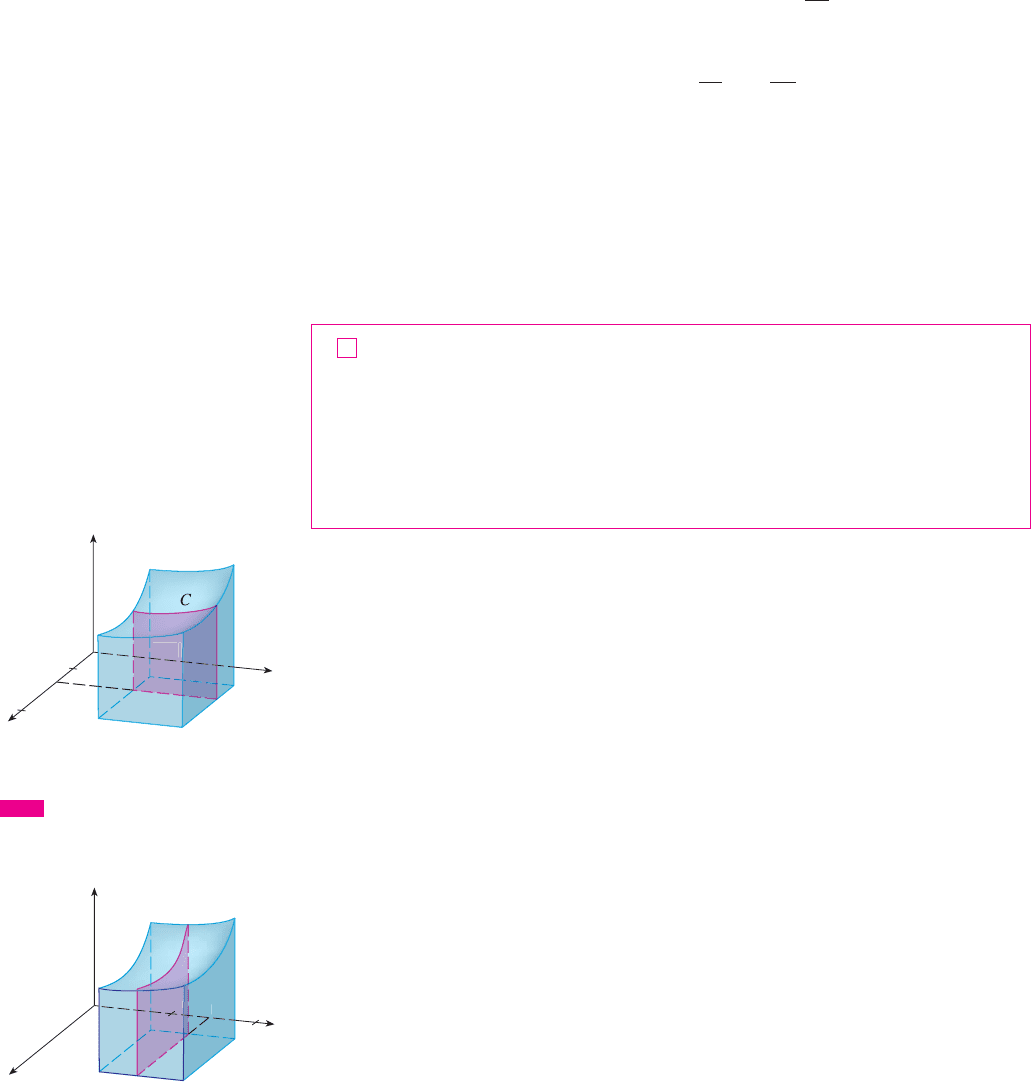
(b) Here we first integrate with respect to :
M
Notice that in Example 1 we obtained the same answer whether we integrated with
respect to or first. In general, it turns out (see Theorem 4) that the two iterated integrals
in Equations 2 and 3 are always equal; that is, the order of integration does not matter.
(This is similar to Clairaut’s Theorem on the equality of the mixed partial derivatives.)
The following theorem gives a practical method for evaluating a double integral by
expressing it as an iterated integral (in either order).
FUBINI’S THEOREM If is continuous on the rectangle
, , then
More generally, this is true if we assume that is bounded on , is discontin-
uous only on a finite number of smooth curves, and the iterated integrals exist.
The proof of Fubini’s Theorem is too difficult to include in this book, but we can at least
give an intuitive indication of why it is true for the case where . Recall that if
is positive, then we can interpret the double integral as the volume of
the solid that lies above and under the surface . But we have another for-
mula that we used for volume in Chapter 6, namely,
where is the area of a cross-section of in the plane through perpendicular to the
-axis. From Figure 1 you can see that is the area under the curve whose equation
is , where is held constant and . Therefore
and we have
A similar argument, using cross-sections perpendicular to the -axis as in Figure 2, shows
that
yy
R
f 共x, y兲 dA 苷
y
d
c
y
b
a
f 共x, y兲 dx dy
y
yy
R
f 共x, y兲 dA 苷 V 苷
y
b
a
A共x兲 dx 苷
y
b
a
y
d
c
f 共x, y兲 dy dx
A共x兲 苷
y
d
c
f 共x, y兲 dy
c y dxz 苷 f 共x, y兲
CA共x兲x
xSA共x兲
V 苷
y
b
a
A共x兲 dx
z 苷 f 共x, y兲RS
Vxx
R
f 共x, y兲 dAf
f 共x, y兲 0
fRf
yy
R
f 共x, y兲 dA 苷
y
b
a
y
d
c
f 共x, y兲 dy dx 苷
y
d
c
y
b
a
f 共x, y兲 dx dy
c y d 其R 苷 兵共x, y兲
ⱍ
a x b
f
4
xy
苷
y
2
1
9y dy 苷 9
y
2
2
册
1
2
苷
27
2
y
2
1
y
3
0
x
2
y dx dy 苷
y
2
1
冋y
3
0
x
2
y dx
册
dy 苷
y
2
1
冋
x
3
3
y
册
x苷0
x苷3
dy
x
SECTION 16.2 ITERATED INTEGRALS
||||
997
N Theorem 4 is named after the Italian mathe-
matician Guido Fubini (1879–1943), who proved
a very general version of this theorem in 1907.
But the version for continuous functions was
known to the French mathematician Augustin-
Louis Cauchy almost a century earlier.
FI
GU
RE
1
a
x
0
z
x
b
y
A(
x
)
Visual 16.2 illustrates Fubini’s
Theorem by showing an animation of
Figures 1 and 2.
TEC
FI
GU
RE
2
0
y
c
x
z
y
d
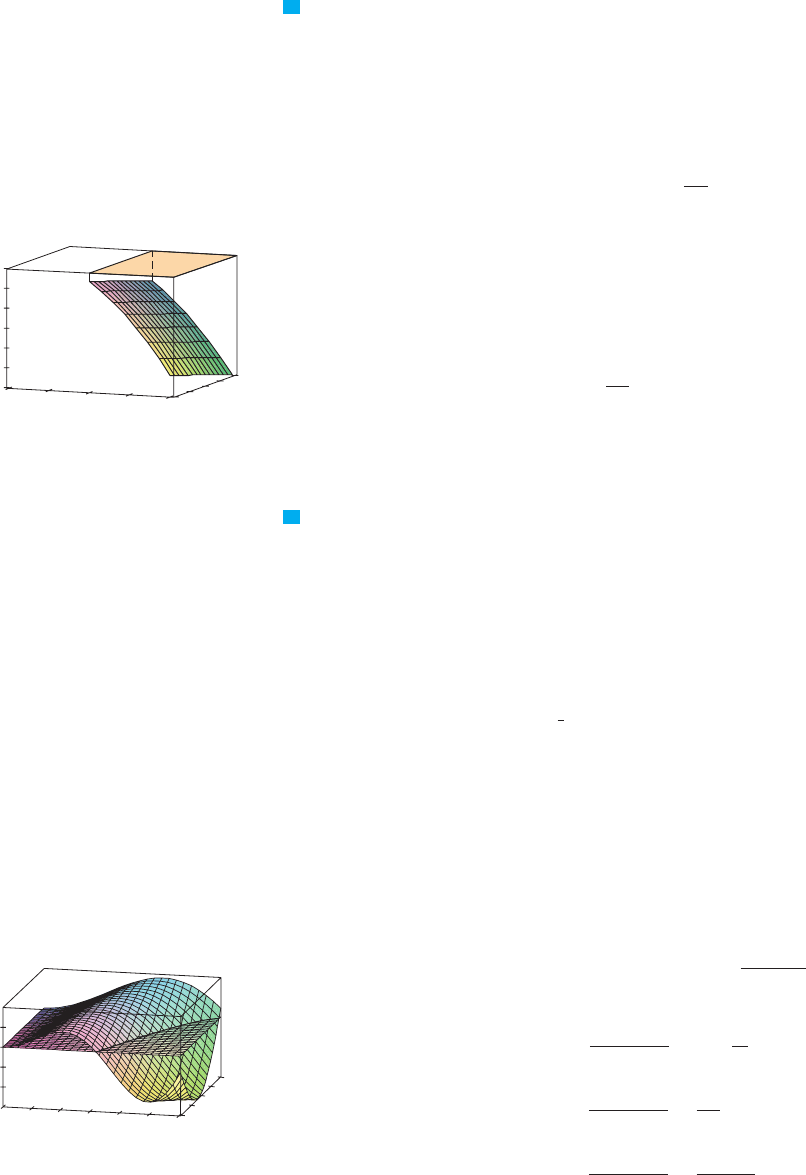
EXAMPLE 2 Evaluate the double integral , where
, . (Compare with Example 3 in Section 16.1.)
SOLUTION 1 Fubini’s Theorem gives
SOLUTION 2 Again applying Fubini’s Theorem, but this time integrating with respect to
first, we have
M
EXAMPLE 3 Evaluate , where .
SOLUTION 1 If we first integrate with respect to , we get
SOLUTION 2 If we reverse the order of integration, we get
To evaluate the inner integral, we use integration by parts with
and so
苷
cos
x
x
sin
x
x
2
苷
cos
x
x
1
x
2
[
sin共xy兲
]
y苷0
y苷
y
0
y sin共xy兲 dy 苷
y cos共xy兲
x
册
y苷0
y苷
1
x
y
0
cos共xy兲 dy
v 苷
cos共xy兲
x
du 苷 dy
dv 苷 sin共xy兲 dy u 苷 y
yy
R
y sin共xy兲 dA 苷
y
2
1
y
0
y sin共xy兲 dy dx
苷
1
2
sin 2y sin y
]
0
苷 0
苷
y
0
共cos 2y cos y兲 dy
苷
y
0
[
cos共xy兲
]
x苷1
x苷2
dy
yy
R
y sin共xy兲 dA 苷
y
0
y
2
1
y sin共xy兲 dx dy
x
R 苷 关1, 2兴 关0,
兴xx
R
y sin共xy兲 dA
V
苷
y
2
1
共2 6y
2
兲
dy 苷 2y 2y
3
]
1
2
苷 12
苷
y
2
1
冋
x
2
2
3xy
2
册
x苷0
x苷2
dy
yy
R
共x 3y
2
兲
dA 苷
y
2
1
y
2
0
共x 3y
2
兲
dx dy
x
苷
y
2
0
共x 7兲 dx 苷
x
2
2
7x
册
0
2
苷 12
苷
y
2
0
[
xy y
3
]
y苷1
y苷2
dx
yy
R
共x 3y
2
兲
dA 苷
y
2
0
y
2
1
共x 3y
2
兲
dy dx
1 y 2其R 苷 兵共x, y兲
ⱍ
0 x 2
xx
R
共x 3y
2
兲
dA
V
998
||||
CHAPTER 16 MULTIPLE INTEGRALS
N Notice the negative answer in Example 2;
nothing is wrong with that. The function in
that example is not a positive function, so its
integral doesn’t represent a volume. From
Figure 3 we see that is always negative on
, so the value of the integral is the
negative
of the volume that lies
above
the graph of
and
below
.R
f
R
f
f
FIGURE 3
R
0
_12
0
0.5
1
1.5
2
2
1
0
y
x
z
_4
_8
z=x-3¥
N For a function that takes on both positive
and negative values, is a differ-
ence of volumes: , where is the vol-
ume above and below the graph of and is
the volume below and above the graph. The
fact that the integral in Example 3 is means
that these two volumes and are equal.
(See Figure 4.)
V
2
V
1
0
R
V
2
fR
V
1
V
1
V
2
xx
R
f 共x, y兲 dA
f
FIGURE 4
z=ysin(xy)
1
0
_1
y
1
0
3
2
2
1
x
z
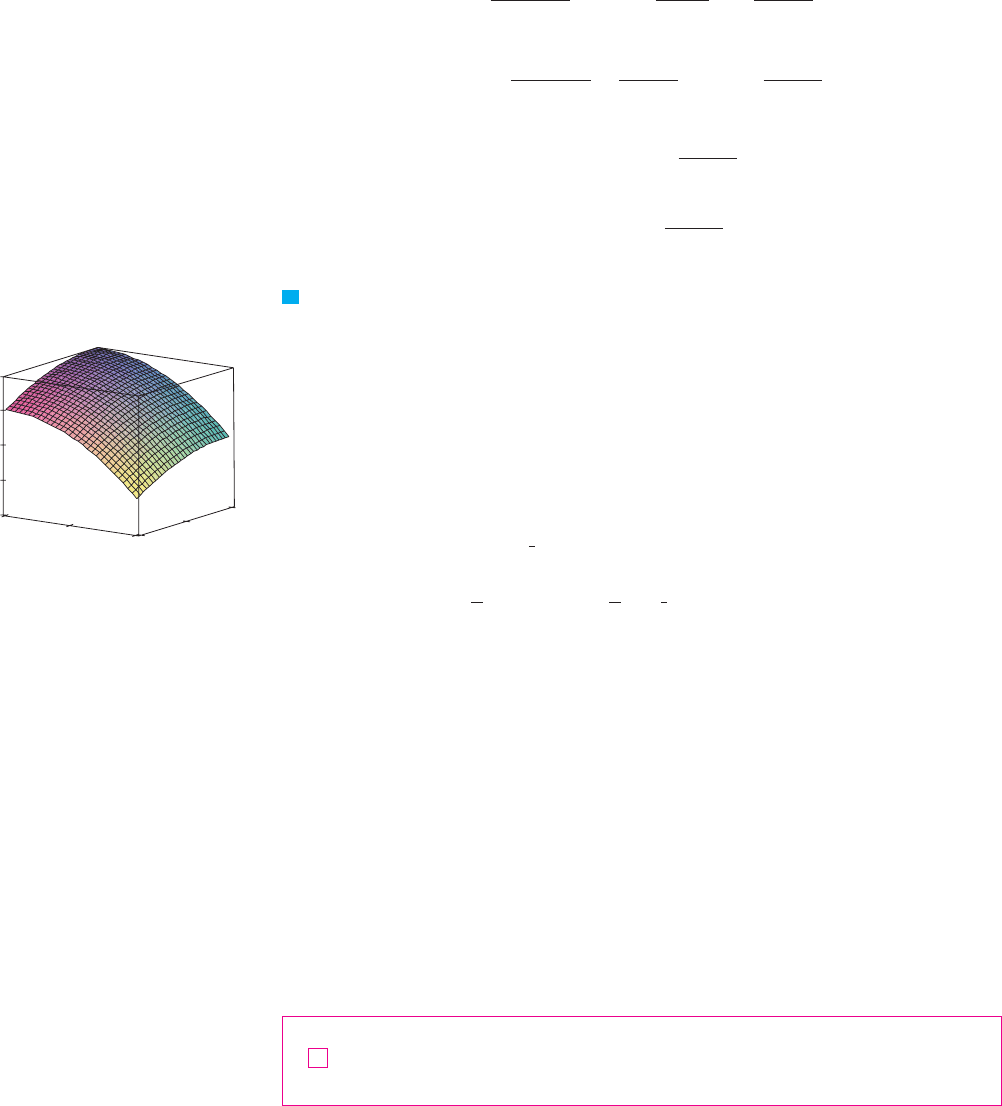
If we now integrate the first term by parts with and , we get
, , and
Therefore
and so
M
EXAMPLE 4 Find the volume of the solid that is bounded by the elliptic paraboloid
, the planes and , and the three coordinate planes.
SOLUTION We first observe that is the solid that lies under the surface
and above the square . (See Figure 5.) This solid was considered in
Example 1 in Section 16.1, but we are now in a position to evaluate the double integral
using Fubini’s Theorem. Therefore
M
In the special case where can be factored as the product of a function of only
and a function of only, the double integral of can be written in a particularly simple
form. To be specific, suppose that and . Then
Fubini’s Theorem gives
In the inner integral, is a constant, so is a constant and we can write
since is a constant. Therefore, in this case, the double integral of can be writ-
ten as the product of two single integrals:
where R 苷 关a, b兴 关c, d兴
yy
R
t共x兲 h共y兲 dA 苷
y
b
a
t共x兲 dx
y
d
c
h共y兲 dy
5
fx
b
a
t共x兲 dx
苷
y
b
a
t共x兲 dx
y
d
c
h共y兲 dy
y
d
c
冋y
b
a
t共x兲h共y兲 dx
册
dy 苷
y
d
c
冋
h共y兲
冉y
b
a
t共x兲 dx
冊册
dy
h共y兲y
yy
R
f 共x, y兲 dA 苷
y
d
c
y
b
a
t共x兲h共y兲 dx dy 苷
y
d
c
冋y
b
a
t共x兲h共y兲 dx
册
dy
R 苷 关a, b兴 关c, d兴f 共x, y兲 苷 t共x兲h共y兲
fy
xf 共x, y兲
苷
y
2
0
(
88
3
4y
2
)
dy 苷
[
88
3
y
4
3
y
3
]
0
2
苷 48
苷
y
2
0
[
16x
1
3
x
3
2y
2
x
]
x苷0
x苷2
dy
V 苷
yy
R
共16 x
2
2y
2
兲
dA 苷
y
2
0
y
2
0
共16 x
2
2y
2
兲
dx dy
R 苷 关0, 2兴 关0, 2兴
z 苷 16 x
2
2y
2
S
y 苷 2x 苷 2x
2
2y
2
z 苷 16
S
V
苷
sin 2
2
sin
苷 0
y
2
1
y
0
y sin共xy兲 dy dx 苷
冋
sin
x
x
册
1
2
y
冉
cos
x
x
sin
x
x
2
冊
dx 苷
sin
x
x
y
冉
cos
x
x
冊
dx 苷
sin
x
x
y
sin
x
x
2
dx
v 苷 sin
xdu 苷 dx兾x
2
dv 苷
cos
x dxu 苷 1兾x
SECTION 16.2 ITERATED INTEGRALS
||||
999
N In Example 2, Solutions 1 and 2 are equally
straightforward, but in Example 3 the first solu-
tion is much easier than the second one. There-
fore, when we evaluate double integrals, it is
wise to choose the order of integration that gives
simpler integrals.
FIGURE 5
0
1
2
2
1
0
y
x
z
16
12
8
4
0
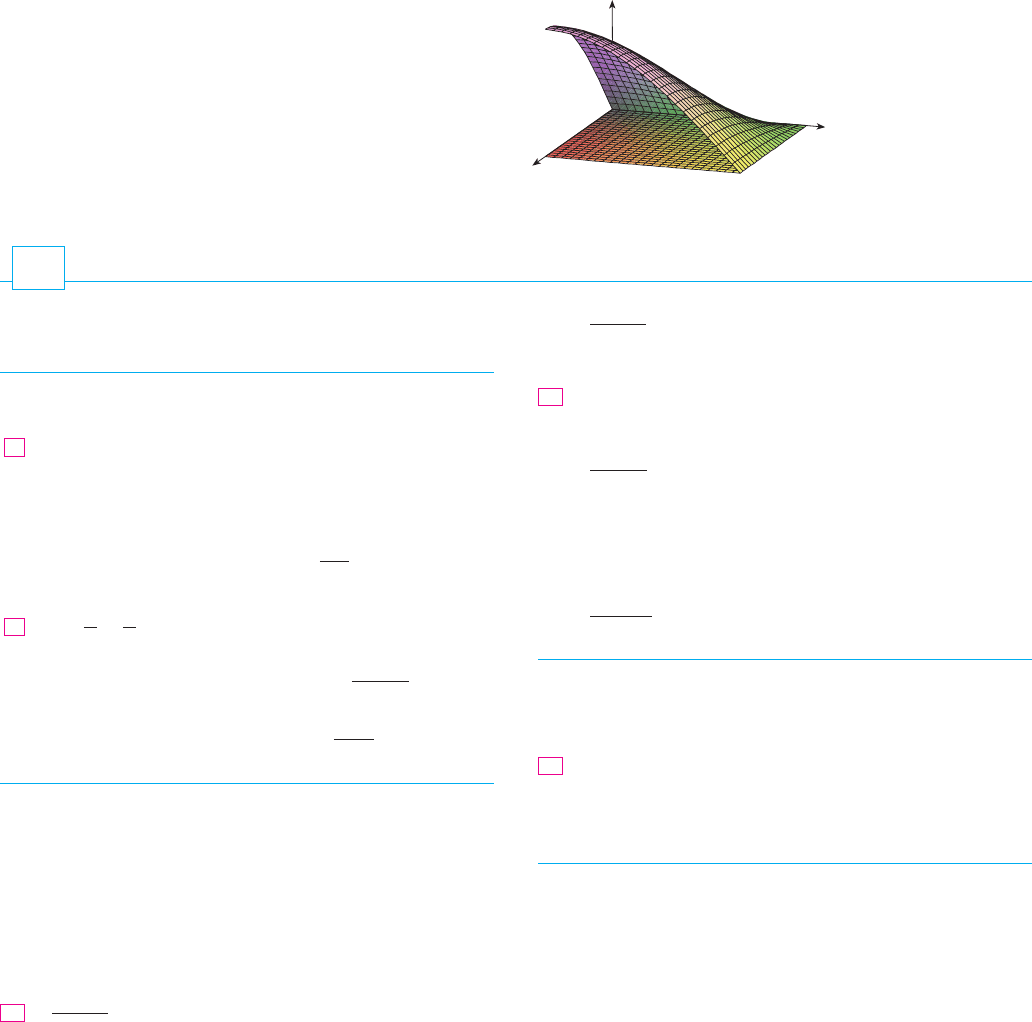
EXAMPLE 5 If , then, by Equation 5,
M
FIGURE 6
y
x
z
0
苷
[
cos x
]
0
兾2
[
sin y
]
0
兾2
苷 1 ⴢ 1 苷 1
yy
R
sin x cos y dA 苷
y
兾2
0
sin x dx
y
兾2
0
cos y dy
R 苷 关0,
兾2兴 关0,
兾2兴
1000
||||
CHAPTER 16 MULTIPLE INTEGRALS
N The function in
Example 5 is positive on , so the integral repre-
sents the volume of the solid that lies above
and below the graph of shown in Figure 6.f
R
R
f 共x, y兲 苷 sin x cos y
18. ,
,
20. ,
21. ,
22. ,
23–24 Sketch the solid whose volume is given by the iterated
integral.
24.
25. Find the volume of the solid that lies under the plane
and above the rectangle
.
26. Find the volume of the solid that lies under the hyperbolic
paraboloid and above the square
.R 苷 关1, 1兴 关0, 2兴
z 苷 4 x
2
y
2
R 苷 兵共x, y兲
ⱍ
0 x 1, 2 y 3其
3x 2y z 苷 12
y
1
0
y
1
0
共2 x
2
y
2
兲
dy dx
y
1
0
y
1
0
共4 x 2y兲 dx dy
23.
R 苷 关1, 2兴 关0, 1兴
yy
R
x
x
2
y
2
dA
R 苷 关0, 1兴 关0, 2兴
yy
R
xye
x
2
y
dA
R 苷 关0, 1兴 关0, 1兴
yy
R
x
1 xy
dA
R 苷 关0,
兾6兴 关0,
兾3兴
yy
R
x sin共x y兲 dA
19.
R 苷 兵共x, y兲
ⱍ
0 x 1, 0 y 1其
yy
R
1 x
2
1 y
2
dA
1–2 Find and .
1. 2.
3–14 Calculate the iterated integral.
4.
5. 6.
7. 8.
10.
11. 12.
13. 14.
15–22 Calculate the double integral.
15. ,
16. ,
, R 苷 兵共x, y兲
ⱍ
0 x 1, 3 y 3其
yy
R
xy
2
x
2
1
dA
17.
R 苷 兵共x, y兲
ⱍ
0 x
, 0 y
兾2其
yy
R
cos共x 2y兲 dA
R 苷 兵共x, y兲
ⱍ
0 x 3, 0 y 1其
yy
R
共6x
2
y
3
5y
4
兲 dA
y
1
0
y
1
0
s
s t ds dt
y
2
0
y
0
r sin
2
d
dr
y
1
0
y
1
0
xy
s
x
2
y
2
dy dx
y
1
0
y
1
0
共u v兲
5
du dv
y
1
0
y
3
0
e
x3y
dx dy
y
4
1
y
2
1
冉
x
y
y
x
冊
dy dx
9.
y
1
0
y
2
1
xe
x
y
dy dx
y
2
0
y
1
0
共2x y兲
8
dx dy
y
兾2
兾6
y
5
1
cos y dx dy
y
2
0
y
兾2
0
x sin y dy dx
y
1
0
y
2
1
共4x
3
9x
2
y
2
兲 dy dx
y
3
1
y
1
0
共1 4xy兲 dx dy
3.
f 共x, y兲 苷 y xe
y
f 共x, y兲 苷 12x
2
y
3
x
1
0
f 共x, y兲 dyx
5
0
f 共x, y兲 dx
EXERCISES
16.2

34. Graph the solid that lies between the surfaces
and for ,
. Use a computer algebra system to approximate the
volume of this solid correct to four decimal places.
35–36 Find the average value of over the given rectangle.
, has vertices , , ,
36. ,
37. Use your CAS to compute the iterated integrals
Do the answers contradict Fubini’s Theorem? Explain what
is happening.
38. (a) In what way are the theorems of Fubini and Clairaut
similar?
(b) If is continuous on and
for , , show that .t
xy
苷 t
yx
苷 f 共x, y兲
c
y
da
x
b
t共x, y兲 苷
y
x
a
y
y
c
f 共s, t兲 dt ds
关a, b兴 关c, d 兴f 共x, y兲
y
1
0
y
1
0
x y
共x y兲
3
dx dyand
y
1
0
y
1
0
x y
共x y兲
3
dy dx
CAS
R 苷 关0, 4兴 关0, 1兴f 共x, y兲 苷 e
y
s
x e
y
共1, 0兲共1, 5兲共1, 5兲共1, 0兲Rf 共x, y兲 苷 x
2
y
35.
f
ⱍ
y
ⱍ
1
ⱍ
x
ⱍ
1z 苷 2 x
2
y
2
z 苷 e
x
2
cos 共x
2
y
2
兲
CAS
Find the volume of the solid lying under the elliptic
paraboloid and above the rectangle
.
28. Find the volume of the solid enclosed by the surface
and the planes , , ,
and .
29. Find the volume of the solid enclosed by the surface
and the planes , , , ,
and .
30. Find the volume of the solid in the first octant bounded by
the cylinder and the plane .
31. Find the volume of the solid enclosed by the paraboloid
and the planes , , ,
, and .
;
32. Graph the solid that lies between the surface
and the plane and is bounded
by the planes , , , and . Then find its
volume.
33. Use a computer algebra system to find the exact value of the
integral , where . Then use
the CAS to draw the solid whose volume is given by the
integral.
R 苷 关0, 1兴 关0, 1兴
xx
R
x
5
y
3
e
xy
dA
CAS
y 苷 4y 苷 0x 苷 2x 苷 0
z 苷 x 2yz 苷 2xy兾共x
2
1兲
y 苷 4y 苷 0
x 苷 1x 苷 1z 苷 1z 苷 2 x
2
共y 2兲
2
y 苷 5z 苷 16 x
2
y 苷
兾4
y 苷 0x 苷 2x 苷 0z 苷 0z 苷 x sec
2
y
z 苷 0
y 苷
y 苷 0x 苷 1z 苷 1 e
x
sin y
R 苷 关1, 1兴 关2, 2兴
x
2
兾4 y
2
兾9 z 苷 1
27.
SECTION 16.3 DOUBLE INTEGRALS OVER GENERAL REGIONS
||||
1001
DOUBLE INTEGRALS OVER GENERAL REGIONS
For single integrals, the region over which we integrate is always an interval. But for
double integrals, we want to be able to integrate a function not just over rectangles but
also over regions of more general shape, such as the one illustrated in Figure 1. We sup-
pose that is a bounded region, which means that can be enclosed in a rectangular
region as in Figure 2. Then we define a new function with domain by
0
y
x
D
y
0
x
D
R
FIGURE 2FIGURE 1
F共x, y兲 苷
再
0
f 共x, y兲 if
if
共x, y兲 is in D
共x, y兲 is in R but not in D
1
RFR
DD
D
f
16.3
